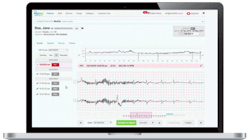Remote patient monitoring represents paradigm shift after COVID-19
As the pandemic is showing signs of abating, InfoBionic CEO Stuart Long addressed in a press release how remote patient monitoring (RPM) technology ensures telehealth is here to stay.
It’s no secret that the use of telehealth technologies rose dramatically with the onset of the COVID-19 pandemic. In efforts to keep patients safe, doctors across the country turned to RPM to evaluate and monitor patients while keeping them at home. Even before the pandemic, nine out of ten healthcare providers indicated they were evaluating or had already invested in RPM technologies to better assist their patients. And now, as America seems to be rounding out of the pandemic, telehealth and RPM are here to stay—so believes the American Medical Association.
“COVID-19 strained our already overburdened healthcare system to the max, and many doctors chose to go with remote patient monitoring to help alleviate that strain and keep patients safe from COVID-19. But not all RPM devices are created equal, and doctors need to feel confident that their choice of technology provides a truly comprehensive picture of a patient’s health,” explains Stuart Long, CEO of InfoBionic, a digital health technology company.
RPM uses innovative technological tools to gather and track patient data outside standard healthcare settings. Cardiology was one of the first medical specialties to incorporate RPM into standard practice. Some studies already show that patients using RPM showed a 50% drop in mortality from arrhythmias and congestive heart failure compared to those receiving standard, in-person follow-up.
InfoBionic introduced the MoMe Kardia as the first mobile cardiac telemetry (MCT) technology that provides near real-time on-demand full disclosure of ECG data 24/7. Using a one-piece monitor, MoMe continuously records telemetry data, uploading it to a cloud-based platform that clinicians may access anytime, anywhere. Automated reports show onset, offset, and other supplementary data that any cardiologist may use to verify or rule out cardiac events. MoMe presents this information in a HIPAA-compliant portal that helps to protect sensitive patient health information.
In addition to benefitting the patient, cardiac RPM devices help the clinician as well:
· By remotely transitioning the monitor between Holter, Event, and MCT during monitoring periods (depending on patient need), RPM streamlines office and hospital visits.
· Eliminates the need for intermediaries in patient enrollments, IDTF data delays and helps to gain control of patient compliance.
· By recording every single heartbeat and providing on-demand access to 100% of acquired heartbeats, the data can enhance the clinician’s ability to detect—and make timely diagnoses of atrial fibrillation, tachycardia, and other arrhythmias.
· The physician can facilitate decision-making with control of all reporting and get all the data needed to optimize diagnosis accuracy.
Remote cardiac monitoring has become part of the standard of care for cardiac patients, especially those with implantable cardiac devices. Easy access to real-time telemetry data allows cardiologists to decide whether symptoms represent true medical emergencies, essentially creating a “hospital without walls”. Additionally, one-fourth of healthcare organizations report that RPM reduces emergency department visits and hospital readmissions; 38% of organizations say the technology results in fewer inpatient admissions for problems like heart disease or chronic obstructive pulmonary disease.
Current generations of remote patient monitoring technology cannot monitor all vitals—oxygen level, ECG, blood pressure, blood glucose, etc.—at the same time and/or in the same device. However, biotech companies are working to develop a kind of “tricorder” technology, similar to that seen in “Star Trek”.
Doctors, explains Long, will probably use a hybrid model, combining in-person care with virtual visits for a more comprehensive and convenient approach to care. RPM technology will be key to differentiating true emergencies from non-emergent situations, which benefits both the patient and the healthcare system as a whole.
